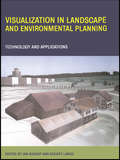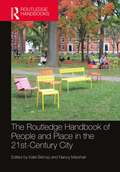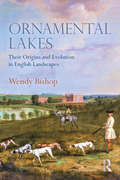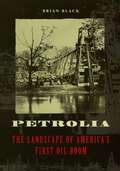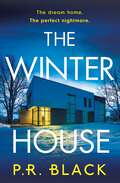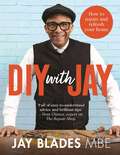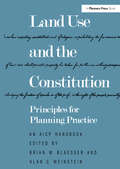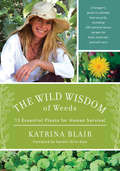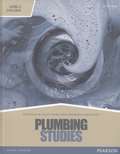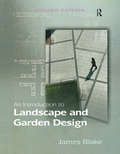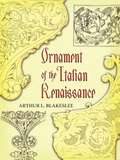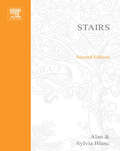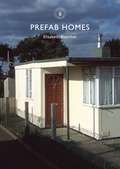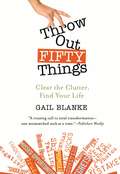- Table View
- List View
Visualization in Landscape and Environmental Planning: Technology and Applications
by Ian Bishop Eckart LangeThis major reference presents the challenges, issues and directions of computer-based visualization of the natural and built environment and the role of such visualization in landscape and environmental planning. It offers a uniquely systematic approach to the potential of visualization and the writers are acknowledged experts in their field of specialization. Case studies are presented to illustrate many aspects of landscape management including forestry, agriculture, ecology, mining and urban development.
Routledge Handbook of Urban Landscape Research (Routledge International Handbooks)
by Kate Bishop Linda CorkeryLandscape architecture is one of the key professions dedicated to making cities hospitable and healthy places to live, work and play, while respecting and enhancing the natural environments and landscapes we inhabit. This edited collection presents current writing about the pivotal roles that landscape architects play in addressing some of the most pressing problems facing the planet, its environments and its populations through their research, analysis and speculative practice. The book has assembled current writings on recent research structured around five major themes: governance, power and partnership; infrastructure, systems and performance; environment, resilience and climate change; people, place and design; and culture, heritage and identity. As a collection, the chapters demonstrate the diversity of themes and topics that are expanding the scholarly body of knowledge for the discipline and its relevance to the practice of landscape architecture. The contributors to this book are academic researchers and practitioners from the discipline of landscape architecture. The chapters draw on their research, teaching and experience as well as analysis of project examples. Fifty-two contributors from the United Stsates, United Kingdom, Sweden, Denmark, the Netherlands, Nigeria, Malaysia, Spain, Colombia, Australia, New Zealand and Canada discuss a diverse range of contemporary themes in urban landscape architecture. Collectively, the contributors demonstrate the breadth of experience, shared concerns and distinct issues that challenge urban landscape architecture and cities in the 21st century.
Routledge Handbook of Urban Landscape Research (Routledge International Handbooks)
by Kate Bishop Linda CorkeryLandscape architecture is one of the key professions dedicated to making cities hospitable and healthy places to live, work and play, while respecting and enhancing the natural environments and landscapes we inhabit. This edited collection presents current writing about the pivotal roles that landscape architects play in addressing some of the most pressing problems facing the planet, its environments and its populations through their research, analysis and speculative practice. The book has assembled current writings on recent research structured around five major themes: governance, power and partnership; infrastructure, systems and performance; environment, resilience and climate change; people, place and design; and culture, heritage and identity. As a collection, the chapters demonstrate the diversity of themes and topics that are expanding the scholarly body of knowledge for the discipline and its relevance to the practice of landscape architecture. The contributors to this book are academic researchers and practitioners from the discipline of landscape architecture. The chapters draw on their research, teaching and experience as well as analysis of project examples. Fifty-two contributors from the United Stsates, United Kingdom, Sweden, Denmark, the Netherlands, Nigeria, Malaysia, Spain, Colombia, Australia, New Zealand and Canada discuss a diverse range of contemporary themes in urban landscape architecture. Collectively, the contributors demonstrate the breadth of experience, shared concerns and distinct issues that challenge urban landscape architecture and cities in the 21st century.
The Routledge Handbook of People and Place in the 21st-Century City
by Kate Bishop Nancy MarshallIncreasing urbanization and increasing urban density put enormous pressure on the relationships between people and place in cities. Built environment professionals must pay attention to the impact of people–place relationships in small- to large-scale urban initiatives. A small playground in a neighborhood pocket park is an example of a small-scale urban development; a national environmental policy that influences energy sources is an example of a large-scale initiative. All scales of decision-making have implications for the people–place relationships present in cities. This book presents new research in contemporary, interdisciplinary urban challenges, and opportunities, and aims to keep the people–place relationship debate in focus in the policies and practices of built environment professionals and city managers. Most urban planning and design decisions, even those on a small scale, will remain in the urban built form for many decades, conditioning people’s experience of their city. It is important that these decisions are made using the best available knowledge. This book contains an interdisciplinary discussion of contemporary urban movements and issues influencing the relationship between people and place in urban environments around the world which have major implications for both the processes and products of urban planning, design, and management. The main purpose of the book is to consolidate contemporary thinking among experts from a range of disciplines including anthropology, environmental psychology, cultural geography, urban design and planning, architecture and landscape architecture, and the arts, on how to conceptualize and promote healthy people and place relationships in the 21st-century city. Within each of the chapters, the authors focus on their specific areas of expertise which enable readers to understand key issues for urban environments, urban populations, and the links between them.
Ornamental Lakes: Their Origins and Evolution in English Landscapes
by Wendy BishopOrnamental Lakes traces the history of lakes in England, from their appearance in the early eighteenth century, through their development in the 1750s, and finally to their decline in the nineteenth century. Aside from the natural lakes in the Lake District, the bodies of water we see in England today are man-made, primarily intended to ornament the landscapes of the upper classes. Through detailed research, author Wendy Bishop argues that, contrary to accepted thinking, the development of lakes led to the dissolution of formal landscapes rather than following changes in landscape design. Providing a comprehensive overview of lakes in England, including data on who made these lakes, how, and when, it additionally covers fishponds, water gardens, cascades and reservoirs. Richly illustrated and accompanied by case studies across the region, this book offers new insights in landscape history for students, researchers and those interested in how landscapes evolve.
Ornamental Lakes: Their Origins and Evolution in English Landscapes
by Wendy BishopOrnamental Lakes traces the history of lakes in England, from their appearance in the early eighteenth century, through their development in the 1750s, and finally to their decline in the nineteenth century. Aside from the natural lakes in the Lake District, the bodies of water we see in England today are man-made, primarily intended to ornament the landscapes of the upper classes. Through detailed research, author Wendy Bishop argues that, contrary to accepted thinking, the development of lakes led to the dissolution of formal landscapes rather than following changes in landscape design. Providing a comprehensive overview of lakes in England, including data on who made these lakes, how, and when, it additionally covers fishponds, water gardens, cascades and reservoirs. Richly illustrated and accompanied by case studies across the region, this book offers new insights in landscape history for students, researchers and those interested in how landscapes evolve.
Petrolia: The Landscape of America's First Oil Boom (Creating the North American Landscape)
by Brian BlackIn Petrolia, Brian Black offers a geographical and social history of a region that was not only the site of America's first oil boom but was also the world's largest oil producer between 1859 and 1873. Against the background of the growing demand for petroleum throughout and immediately following the Civil War, Black describes Oil Creek Valley's descent into environmental hell. Known as "Petrolia," the region charged the popular imagination with its nearly overnight transition from agriculture to industry. But so unrestrained were these early efforts at oil drilling, Black writes, that "the landscape came to be viewed only as an instrument out of which one could extract crude." In a very short time, Petrolia was a ruined place—environmentally, economically, and to some extent even culturally. Black gives historical detail and analysis to account for this transformation.
The Winter House: A dark thriller about a dream home that becomes your worst nightmare
by P.R. BlackThe dream home. The perfect nightmare... Vonny and Seth dream of a place in the country, but they can barely scrape together a deposit for a flat. So when they enter a competition and win a huge, remote plot of land, they can't believe their luck. They start building the house of their dreams and look forward to a happy life together.But then they discover an old suitcase – a suitcase filled with millions of pounds worth of heroin. Their idyllic existence comes crashing down around them. Because the original owner of the suitcase is coming for it...All that stands between Vonny and Seth and their worst nightmare is the house they built. Will their dream home save them – or will the nightmare become reality?This gripping psychological thriller from acclaimed author P.R. Black is an edge-of-your-seat winter read, perfect for fans of The Chalet and The Hunting Party.Reviews for P.R. Black'A slow-burning thriller that builds to a devastating dénouement' Mail on Sunday'It's edge-of-the-seat stuff... A cracker' Bookbag
Green Lewisham: Our treasured open spaces
by Candy BlackhamIn Green Lewisham we are invited to explore the surprisingly numerous green spaces in the Borough of Lewisham in south east London. Rivers, trees, grassy glades and wildlife are round almost every corner, hidden between houses and alongside railway lines and all lying less than ten miles from Trafalgar Square in central London. We have a brief history behind the many calming and natural sites and the photographs tempt us to go walking every day, and at all times of the year, as the trees change from bare branches to green leaves and then the brilliant jewel-like colours of the autumn. Discover herons and egrets, swans, and many, many species of birds as well as the ever-present ring-necked parakeets. Walk along the centuries-old River Ravensbourne and its tributaries, or find stunning views of London from the hilltops. Lewisham is celebrated as the London Borough of Culture in 2022. Candy Blackham has given us a unique book which opens our eyes to appreciating and enjoying the natural, green spaces in this special year.
DIY with Jay: How to Repair and Refresh Your Home
by Jay BladesLearn how to create a home you'll love with this illustrated full-colour practical guide from the Sunday Times bestselling author and star of the hit primetime show The Repair Shop, Jay Blades.Even if you've never put up a shelf, repainted a room or fixed a dripping tap, you'll soon have the confidence and skills to tackle these DIY jobs and many more with Jay's help! With tales of his own do-it-yourself escapades and plenty of inspiration from his favourite home fixes, this accessible and entertaining guide will give you all the knowledge you need to choose the right wall plugs, revamp those old dining chairs and give your bathroom a whole new lease of life without breaking the bank.DIY with Jay is a room-by-room guide to doing it yourself: from laying new kitchen flooring and building your own BBQ to making new sofa covers and choosing the right bedroom vibe for the best night's sleep. Based on his own many years of experience as a furniture restorer, this manual provides tips and problem solvers for anyone hoping to embark on a new DIY journey. With tools, terms and expert advice, you'll be able to give new life to your home for years to come.
Land Use and the Constitution: Principles for Planning Practice
by Brian W. Blaesser Clyde W. Forrest Douglas W. Kmiec Daniel R. Mandelker Alan C. Weinstein Norman WilliamsThis practical handbook explains eight constitutional principles and applies them to real-world planning situations. These statements of principles reflect consensus opinions, but the book also discusses points of dissent. It includes detailed summaries of more than fifty U.S. Supreme Court cases affecting land-use planning, along with a comprehensive table of contents, a cross-referenced index, three matricies that relate sections of the book to one another, and a summary of constitutional principles that relates them to land-use planning techniques. All of these features make it easy to locate key constitutional principles quickly. This book is the result of a 1987 symposium that brought together two dozen leading practitioners and scholars in the fields of planning and law.
Land Use and the Constitution: Principles for Planning Practice
by Brian W. Blaesser Alan C. WeinsteinThis practical handbook explains eight constitutional principles and applies them to real-world planning situations. These statements of principles reflect consensus opinions, but the book also discusses points of dissent. It includes detailed summaries of more than fifty U.S. Supreme Court cases affecting land-use planning, along with a comprehensive table of contents, a cross-referenced index, three matricies that relate sections of the book to one another, and a summary of constitutional principles that relates them to land-use planning techniques. All of these features make it easy to locate key constitutional principles quickly. This book is the result of a 1987 symposium that brought together two dozen leading practitioners and scholars in the fields of planning and law.
Design Mom: How to Live with Kids: A Room-by-Room Guide
by Gabrielle Stanley BlairNew York Times best seller Ever since Gabrielle Stanley Blair became a parent, she&’s believed that a thoughtfully designed home is one of the greatest gifts we can give our families, and that the objects and decor we choose to surround ourselves with tell our family&’s story. In this, her first book, Blair offers a room-by-room guide to keeping things sane, organized, creative, and stylish. She provides advice on getting the most out of even the smallest spaces; simple fixes that make it easy for little ones to help out around the house; ingenious storage solutions for the never-ending stream of kid stuff; rainy-day DIY projects; and much, much more.
The Wild Wisdom of Weeds: 13 Essential Plants for Human Survival
by Katrina Blair Sandor Ellix KatzThe Wild Wisdom of Weeds is the only book on foraging and edible weeds to focus on the thirteen weeds found all over the world, each of which represents a complete food source and extensive medical pharmacy and first-aid kit. More than just a field guide to wild edibles, it is a global plan for human survival. When Katrina Blair was eleven she had a life-changing experience where wild plants spoke to her, beckoning her to become a champion of their cause. Since then she has spent months on end taking walkabouts in the wild, eating nothing but what she forages, and has become a wild-foods advocate, community activist, gardener, and chef, teaching and presenting internationally about foraging and the healthful lifestyle it promotes. Katrina Blair’s philosophy in The Wild Wisdom of Weeds is sobering, realistic, and ultimately optimistic. If we can open our eyes to see the wisdom found in these weeds right under our noses, instead of trying to eradicate an “invasive,” we will achieve true food security. The Wild Wisdom of Weeds is about healing ourselves both in body and in spirit, in an age where technology, commodity agriculture, and processed foods dictate the terms of our intelligence. But if we can become familiar with these thirteen edible survival weeds found all over the world, we will never go hungry, and we will become closer to our own wild human instincts—all the while enjoying the freshest, wildest, and most nutritious food there is. For free! The thirteen plants found growing in every region across the world are: dandelion, mallow, purslane, plantain, thistle, amaranth, dock, mustard, grass, chickweed, clover, lambsquarter, and knotweed. These special plants contribute to the regeneration of the earth while supporting the survival of our human species; they grow everywhere where human civilization exists, from the hottest deserts to the Arctic Circle, following the path of human disturbance. Indeed, the more humans disturb the earth and put our food supply at risk, the more these thirteen plants proliferate. It’s a survival plan for the ages. Including over one hundred unique recipes, Katrina Blair’s book teaches us how to prepare these wild plants from root to seed in soups, salads, slaws, crackers, pestos, seed breads, and seed butters; cereals, green powders, sauerkrauts, smoothies, and milks; first-aid concoctions such as tinctures, teas, salves, and soothers; self-care/beauty products including shampoo, mouthwash, toothpaste (and brush), face masks; and a lot more. Whether readers are based at home or traveling, this book aims to empower individuals to maintain a state of optimal health with minimal cost and effort.
Level 2 Diploma in Plumbing Studies Candidate Handbook (PDF)
by Stephen Blair Phillip Davies Terry Grimwood Andy JeffreyWritten by experienced tutors in line with the level 2 specification to help prepare learners for progression into an Apprenticeship and employment. Professional case studies focus on employability skills and help learners develop the soft skills to aid job hunting and performance in the workplace. The content is logically designed and highly visual which makes plumbing principles easier to digest, understand and remember.
An Introduction to Landscape and Garden Design
by James BlakeHow do you design a landscape book suitable for its intended uses? How can the natural qualities of a landscape be enhanced with new features and focal points? How can you make pedestrians stay on the footpath? What kind of plant, path or wall should you put where, and what sort of contract should you choose for your client's contractor? This refreshingly down-to-earth introduction to the vast subject of landscape design and construction answers all these questions, guiding new students through the many facets of professional practice and welding together the artistic, legal, financial, environmental and management issues which can seem so dauntingly disconnected. Illustrated with original drawings, photographs, sample plans and facsimiles, including a new colour plate section, this readable classic has been fully revised and updated throughout. It opens with a completely new chapter which explains design and aesthetic principles, explores the history of our relationship to landscape, and shows how design principles can be applied to influence reactions to the finished site. The author then considers different elements of hard landscape and their relative merits in different situations. The soft landscape section includes coverage of the effects of mass and form, natural and abstract planting, and the difficult subject of plant selection. A step-by-step guide through all the stages of managing a project, from initial discussions with clients, site inspection, surveying and quoting, through tendering, contracting, contractual agreements, development from concept design to final plans and drawings, as well as maintenance, now includes the current information on CDM regulations and provides readers with a plain-speaking reference on client management and contractual administration. Added to the guide to drawing and lettering is an extensive section on computer-aided design. A bibliography and list of useful organization are also included.
An Introduction to Landscape and Garden Design
by James BlakeHow do you design a landscape book suitable for its intended uses? How can the natural qualities of a landscape be enhanced with new features and focal points? How can you make pedestrians stay on the footpath? What kind of plant, path or wall should you put where, and what sort of contract should you choose for your client's contractor? This refreshingly down-to-earth introduction to the vast subject of landscape design and construction answers all these questions, guiding new students through the many facets of professional practice and welding together the artistic, legal, financial, environmental and management issues which can seem so dauntingly disconnected. Illustrated with original drawings, photographs, sample plans and facsimiles, including a new colour plate section, this readable classic has been fully revised and updated throughout. It opens with a completely new chapter which explains design and aesthetic principles, explores the history of our relationship to landscape, and shows how design principles can be applied to influence reactions to the finished site. The author then considers different elements of hard landscape and their relative merits in different situations. The soft landscape section includes coverage of the effects of mass and form, natural and abstract planting, and the difficult subject of plant selection. A step-by-step guide through all the stages of managing a project, from initial discussions with clients, site inspection, surveying and quoting, through tendering, contracting, contractual agreements, development from concept design to final plans and drawings, as well as maintenance, now includes the current information on CDM regulations and provides readers with a plain-speaking reference on client management and contractual administration. Added to the guide to drawing and lettering is an extensive section on computer-aided design. A bibliography and list of useful organization are also included.
Ornament of the Italian Renaissance
by Arthur L. BlakesleeThis glorious gallery of stunning architectural accents from Italy's Middle Ages has been assembled from a rare, early-twentieth-century publication: * Grotesques from carved panels of choir stalls* Breathtaking tombstone and ceiling ornaments * Sumptuous stone balcony panels... and much more, all reproduced in sixty richly detailed illustrations. Designers and artists of every variety will revel in this modestly priced treasury of authentic Renaissance style.
The Lost Orchard: A French chef rediscovers a great British food heritage
by Raymond BlancPICKED BY DIANA HENRY AS ONE OF THE TELEGRAPH'S COOKBOOKS OF THE YEAR 2019.'The legendary chef opens the door to a living library of lost varieties of heritage English fruit in a treasury of recipe and reflection.' Waterstones Weekly'Blanc set about the most thorough apple-tasting and cooking project I have heard of . . . [The Lost Orchard] condenses the highlights, his love letters to the forgotten apple breeds.' The Times'I began to dream about an orchard filled with thousands of fruit trees... Today we have an orchard with over 150 ancient varieties of apple. Each one has its heritage in a village or a county that used to thrive on that particular variety. They tell the story not only of what we have lost in Britain but also what we could regain.'Over the past seven years, Raymond Blanc has planted an orchard of 2,500 trees in the grounds of his hotel-restaurant in Oxfordshire. Yielding about 30 tonnes of fruit for his kitchen each year, it is full of ancient and forgotten varieties of British apples and pears, along with walnut trees, quince, medlars, apricots, nectarines, peaches, plums, damsons and cherries. A further 600 heritage fruit trees have been added from Raymond's home region of Franche-Comté in France. The Lost Orchard is a love letter to each of these varieties, complete with beautiful black and white drawings, photographs of Belmond Le Manoir and fascinating information and anecdotes about each fruit, along with recipes and stories.
Stairs
by Sylvia Blanc Alan BlancStairs are a fundamental and universal feature of buildings. The late Alan Blanc had a lifetime's obsession with stairs and steps and provided a definitive reference source that bridges the aesthetic and practical aspects of staircase design. His wife Sylvia, who worked with him on the first edition, presents this updated, abridged version alongside a complimentary web site where the historical elements of the subjects are described and discussed in pictures and diagrams. The book is a practical guide to designing circulation spaces. It is extensively detailed with working drawings and photographs. Construction methods using a variety of materials are discussed as well as the influence of new technology on vertical circulation. The guidance on codes and regulations covers the UK and US. The latest high profile international case studies inspire and inform the reader.
Stairs
by Sylvia Blanc Alan BlancStairs are a fundamental and universal feature of buildings. The late Alan Blanc had a lifetime's obsession with stairs and steps and provided a definitive reference source that bridges the aesthetic and practical aspects of staircase design. His wife Sylvia, who worked with him on the first edition, presents this updated, abridged version alongside a complimentary web site where the historical elements of the subjects are described and discussed in pictures and diagrams. The book is a practical guide to designing circulation spaces. It is extensively detailed with working drawings and photographs. Construction methods using a variety of materials are discussed as well as the influence of new technology on vertical circulation. The guidance on codes and regulations covers the UK and US. The latest high profile international case studies inspire and inform the reader.
Pool Care For Dummies
by Kristine BlanchardCrystal-clear advice for maintaining a crystal-clear swimming pool Keeping a swimming pool ready for use requires some chemistry know-how, an understanding of how pool mechanics work, and some time spent doing good old-fashioned cleaning work. Pool Care For Dummies offers a reliable, comprehensive resource for building the knowledge that lets you turn pool maintenance into a do-it-yourself task. Written by a certified swimming pool professional who started taking care of pools when she was 5 years old, this book helps you separate the good advice from the bad as you learn to build an upkeep schedule, figure out what chemicals you actually need and which are less-than-magical potions, and fix the common problems that plague all pool owners. With so much trustworthy pool care advice in one place, you can finally cut back on time spent searching for swimming pool advice and more time splashing with your friends and family! Learn how pools work and get the tools you need to keep your pool running Test your water and maintain a safe swimming environment Care for your and balance your above-ground or in-ground pool Know what to do when unexpected problems arisePrivate pool owners who need to know what’s what in the water will love this clear and complete Dummies guide.
Pool Care For Dummies
by Kristine BlanchardCrystal-clear advice for maintaining a crystal-clear swimming pool Keeping a swimming pool ready for use requires some chemistry know-how, an understanding of how pool mechanics work, and some time spent doing good old-fashioned cleaning work. Pool Care For Dummies offers a reliable, comprehensive resource for building the knowledge that lets you turn pool maintenance into a do-it-yourself task. Written by a certified swimming pool professional who started taking care of pools when she was 5 years old, this book helps you separate the good advice from the bad as you learn to build an upkeep schedule, figure out what chemicals you actually need and which are less-than-magical potions, and fix the common problems that plague all pool owners. With so much trustworthy pool care advice in one place, you can finally cut back on time spent searching for swimming pool advice and more time splashing with your friends and family! Learn how pools work and get the tools you need to keep your pool running Test your water and maintain a safe swimming environment Care for your and balance your above-ground or in-ground pool Know what to do when unexpected problems arisePrivate pool owners who need to know what’s what in the water will love this clear and complete Dummies guide.
Prefab Homes (Shire Library #788)
by Elisabeth BlanchetAt the end of the Second World War Winston Churchill promised to manufacture half a million prefabricated bungalows to ease the housing shortage; in the end more than 156,000 temporary 'prefabs' were delivered. Nicknamed 'Palaces for the People', and with convenient kitchens, bathrooms and heating systems, they proved popular and instead of being demolished as intended they were defended by residents who campaigned to keep their family homes and communities. Nearly seventy years later, as the last of these two bedroom homes are being demolished, Elisabeth Blanchet tells the story of these popular dwellings and their gardens and shows the various designs that were produced. Through the stories and memories of residents, she also reveals the communities who were pleased to live in the prefabs.
Throw Out Fifty Things: Clear the Clutter, Find Your Life
by Gail Blanke"A perfect guide to getting the non-essentials out of the way, so that simple joys can make their way into our lives." -- Marianne Williamson, author of A Return to Love "If you want to grow, you gotta let go," is the mantra that bestselling author, columnist, and life coach Gail Blanke lives by. That means eliminating all the clutter - physical and emotional - that holds you back, weighs you down, or just makes you feel bad about yourself. In Throw Out Fifty Things she takes us through each room of the house - from the attic to the garage - and even to the far reaches of our minds. Through poignant and humorous stories, she inspires us to get rid of the "life plaque" we've allowed to build-up there.That junk drawer (you know that drawer) in the kitchen? Empty it! Those old regrets? Throw 'em out! That make-up from your "old" look? Toss it! That relationship that depresses you? Dump it! Once you've hit fifty (you'll be surprised how easy it is to get there) and once you've thrown out that too-tight belt and too-small view of yourself, you'll be ready to step out into the clearing and into the next, and greatest, segment of your life.
